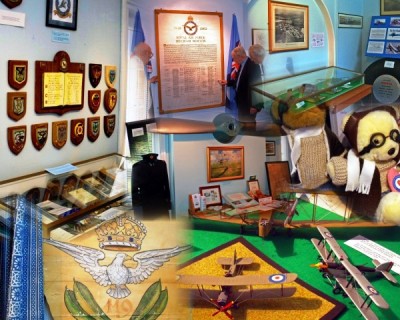
This page of our Website has been created because of the RAF Administrative Apprentices Association’s link with RAF Bircham Newton which was one of its 3 training units (Administrative Apprentice Training Schools). Further information about training at Bircham Newton and its history are contained in other pages in the site listed under Bircham Newton.
Information about Opening Times and Forthcoming Events can be obtained here:
Soon after the birth of the Royal Air Force in April 1918, Bircham Newton was 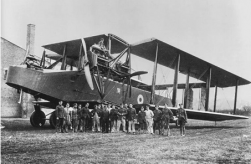 one of the first stations to be opened by the newly-formed Air Ministry. In May of that year the first flying unit, No. 3 Fighting School, arrived for a stay of six months. In the meanwhile a bomber force called the Independent Force was formed to bomb targets in Germany. Two of its squadrons of Handley Page V/1500 aircraft began to form at Bircham Newton, but due to delays in production and other problems, the Armistice was signed before any bombing operations took place. Bircham Newton remained a bomber station until 1936. Many famous squadrons spent varying periods on the station, and its bumpy grass airfield became familiar to hundreds of RAF pilots.
one of the first stations to be opened by the newly-formed Air Ministry. In May of that year the first flying unit, No. 3 Fighting School, arrived for a stay of six months. In the meanwhile a bomber force called the Independent Force was formed to bomb targets in Germany. Two of its squadrons of Handley Page V/1500 aircraft began to form at Bircham Newton, but due to delays in production and other problems, the Armistice was signed before any bombing operations took place. Bircham Newton remained a bomber station until 1936. Many famous squadrons spent varying periods on the station, and its bumpy grass airfield became familiar to hundreds of RAF pilots.
In 1936 Bircham Newton was transferred to Coastal Command to begin the maritime operations on which it was employed throughout the Second World War. Bircham Newton’s flying units, which included Canadian, Dutch and Fleet Air Arm squadrons, flew convoy escort, anti-shipping, air-sea rescue, and photographic and meteorological reconnaissance missions. Some of its aircraft were also used to swell Bomber Command’s strength during early mass-bomber raids. Flying units from Bircham Newton were also used to support the Dunkirk evacuation and the subsequent D-Day landings. With peace in 1945, Bircham Newton’s maritime role came to an end.
When operational flying ceased at the end of the Second World War Bircham Newton was initially transferred to Fighter Command and a period of inactivity ensued. However, flying started again when the station was transferred to Transport Command in late 1946. Initially a BABS Flight arrived with supporting radio aids training units, to provide aircrew training on the Beam Approach Beacon System. This was followed by the Transport Command Initial Conversion Unit, which provided introductory aircrew training, although no aircraft were involved. These units were disbanded prior to the station’s transfer to Technical Training Command in October 1948.
The Officers’ Advanced Training School was transferred to Bircham Newton in late 1948 and was quickly joined by the Secretarial and Equipment Officers’ schools in the spring of 1949. With effect from mid-1951 the whole training establishment became known as the RAF School of Administration, responsible for training thousands of RAF officers and students from foreign and Commonwealth countries. The Officers’ Advanced Training School subsequently became known as the Junior Command and Staff School in 1958. From 1959 until 1962 Bircham Newton was also the home of the Administrative Apprentices’ Training School. This school provided 20 months of intense training for young men to learn their RAF trades of Clerk Secretarial, Pay Accountant or Supplier.
Under the guidance of its first Chairman, Neil Grant, and two other trustees, David Jacklin, the present Chairman and Secretary and Brian Hall, the project was launched in April 2005 and registered as a charity. The Chairman and trustees had all served in the Royal Air Force. Three new trustees also have Royal Air Force connections. The patron is Sir Michael Oswald, currently Honorary Air Commodore of No 2620 Squadron, Royal Auxiliary Air Force Regiment.
The aims of the project are to commemorate the distinguished history of Royal Air Force Bircham Newton and its satellite airfields. The Construction Industry Training Board, now known as Construction Skills, generously provided accommodation within the National Construction College, and a Heritage Room was established, displaying archive material in the form of stories, memorabilia, photographs, maps and drawings from Bircham Newton’s past. Two permanent stone memorials have also been erected and dedicated to those who served at Bircham Newton and the main satellite airfield at nearby docking.
Several illustrated talks about the project and the history of the airfields have been given to clubs and other interested parties around East Anglia. Such talks can be arranged upon request and in return for a small project donation.
The project maintains a Facebook Site which can be accessed at:
https://www.facebook.com/groups/455568478629653/
For further information contact:
Jamie Heffer Tel 07807098348 or Email: jamie_heffer@hotmail.
He can be contacted on 01379 741884 or by e-mail at djacklin@aol.com . Alternatively, you may write to him at 2 Fairways, Stuston, Diss, Norfolk IP21 4AB. He is also the contact for talks.
The Heritage Centre at Bircham Newton has a unique collection of memorabilia from the former Royal Air Force station’s past service, which spanned more than 44 years, including two world wars and the Cold War. On display are photographs and personal memories of servicemen who served there and other related items from its fascinating history. The Centre is manned and run entirely by volunteers, many of whom are ex-servicemen or children of service personnel. Close by there are two stone memorials to remember those who served at Bircham Newton and its main satellite airfield near Docking.
Patron:
MRAF David Brownrigg Craig, Baron Craig of Radley GCB OBE He lives in Norfolk. Baron Craig had a varied and interesting career in the RAF which included tours as Station Commander RAF Akrotiri and Commander in Chief HQSTC at High Wycombe.
Administrator Note July 2011: Avril MacArthur is a trustee and assistant curator at the museum. Her late father FS Christopher Bush was an ex-Apprentice Clerk (51st Entry) at RAF Ruislip. He served at Bircham Newton from 1947 until 1949. Avril has kindly provided me with a series of images in relation to her father and these are shown on the Ruislip page of the site.
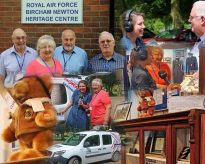 Dixie Dean has kindly forwarded this collage of images from the visit of Radio Norfolk’s Treasure Quest team on Sunday, 28th of May.
Dixie Dean has kindly forwarded this collage of images from the visit of Radio Norfolk’s Treasure Quest team on Sunday, 28th of May. 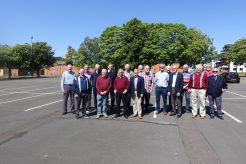
A centenary event was held at RAF Bircham Newton over the weekend of 18/19/20 May to mark the 100th anniversary of the opening of the Station. Forty former admin apprentices of the 32nd to 46th Entries, who carried out some or all of their training there, took part in the celebrations and enjoyed a formal dinner on the Saturday evening. Some of the members who attended are pictured on the old parade ground during a walk around the site.
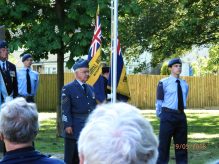
Thank you to those entries who supported the Veterans Day event at Bircham Newton on the 19 May 2018 to mark the centenary of the birth of Bircham Newton as a flying station. A more detailed report will be given in the September 2018 newsletter
Armistice Day Ceremony 2019
The links below will take you to some of the images taken at the 2019 Remembrance Ceremony held on 10th November. Dixie Dean and Barrie Loftus both attended with Dixie laying a wreath in memory of the late Tom Price-Rees (40th) and Barrie laying one in memory of all who served at the station between 1918 and 1962.Click the links to view the images:
Armistice Day 2018
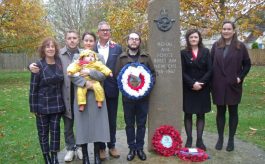
A small ceremony was conducted at the Heritage Centre to mark the the centenary of the signing of the Armistice which ended the First World War. WWI poems were read and wreaths laid at the RAF Bircham Newton Memorial including one laid by Dixie Dean 40th on behalf of all of those who served at Bircham Newton. Barrie Loftus 41st Entry also attended.
Special guests at Bircham Newton were Clive Parish and his wife together with Clive’s family including his children and grandchild. Clive also laid a wreath as shown in the photograph.
Clive’s father, Eric Parish, served as an Armourer in the Great War working on a one ton bomb that was being developed for the Handley Page V/1500 bombers that were based at Bircham Newton in 1918. As a dedication to his father, who died on Armistice day 1973, Clive read a poem he had composed entitled ”One Ton”.
Another special guest at the ceremony was Mrs Kay Lamb whose late father had donated several items of RAF memorabilia to the Heritage Centre. The items had previously belonged to her grandfather, Mr FE Newton, who had served as a gunner at Bircham Newton in the 1920s. Kay was shown photographs, that she had previously not seen, and a story he had written about his school days in the nearby village of Syderstone.